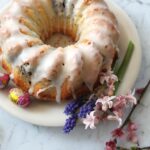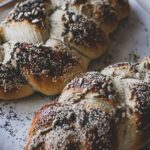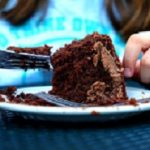
Every January, as the glow of Christmas fades and the New Year begins, German bakeries fill their windows with something golden, fragrant, and deeply symbolic: the Three Kings’ Cake. Soft, slightly sweet, and studded with raisins or pearl sugar, this festive bread ring has brought warmth and joy to Epiphany celebrations for centuries. Whether enjoyed at breakfast, shared at a family gathering, or presented as a special treat for children, Three Kings’ Cake represents good fortune, community, and the start of a fresh chapter.
Also known in German-speaking regions as Dreikönigskuchen, this cake is shaped like a crown or a ring, often divided into pull-apart rolls. Hidden inside is a small token – traditionally a bean, almond, or tiny figure. Whoever finds it becomes “king” or “queen” for the day, a delightful tradition children eagerly await.
At first glance, Three Kings’ Cake resembles a soft brioche. But what makes it uniquely German is its gentle sweetness, its buttery aroma, and its symbolism tied to the Three Wise Men who, according to Christian tradition, visited the infant Jesus on January 6th.
In this guide, we’ll explore the origins of the cake, outline the authentic ingredients, and walk you step by step through making your own Three Kings’ Cake at home – perfect for celebrating Epiphany with family or adding a little midwinter warmth to your table.
The Origins of Three Kings’ Cake
The history of the Three Kings’ Cake stretches back well over a thousand years. Epiphany, celebrated on January 6th, is one of the oldest Christian holidays, commemorating the arrival of the Magi from the East. By medieval times, Christians across Europe had adopted the custom of baking a special cake for the occasion, often hiding a bean (Königsbohne) inside to symbolize the moment of revelation.
In France, this tradition became the Galette des Rois; in Spain, the Roscón de Reyes. Germany’s version, Dreikönigskuchen, developed its own character – a soft yeast bread instead of a pastry, shaped into a circular crown representing royalty and unity. Each pull-apart roll symbolizes one of the Three Kings, though modern German bakers often form seven or eight segments for easier sharing.
By the 19th century, Three Kings’ Cake was firmly part of Epiphany celebrations in southern Germany, Switzerland, and Austria. Children would eagerly search for the hidden bean or almond, and whoever found it could wear a paper crown and enjoy special privileges for the day.
Today, the tradition continues with great enthusiasm. Bakeries sell elaborate versions decorated with almond slivers, pearl sugar, and candied fruit. But homemade versions remain especially loved – warm from the oven, fragrant with butter and citrus, and shared among family and friends as a symbol of hope, joy, and togetherness.
To explore more German holiday traditions, visit our guide to German Christmas Dishes on GermanCulture.com.ua.
Ingredients for Authentic Three Kings’ Cake
This recipe creates a soft, buttery crown of yeast rolls – tender inside with a golden crust. High-quality ingredients and proper rising time are key to success.
Ingredients (serves 8-10):
- 500 g (4 cups) all-purpose flour
- 70 g (⅓ cup) granulated sugar
- 1 packet (7 g) active dry yeast or 25 g fresh yeast
- 250 ml (1 cup) lukewarm milk
- 80 g (⅓ cup) unsalted butter, softened
- 1 large egg
- 1 tsp vanilla extract or 1 packet vanilla sugar
- Zest of 1 organic lemon or orange
- 1 pinch salt
- 80 g (½ cup) raisins or dried cranberries (optional)
For Brushing and Decoration:
- 1 egg yolk mixed with 1 tbsp milk
- Pearl sugar or sliced almonds
- Powdered sugar (optional for dusting)
- A small almond, bean, or heatproof charm for the tradition
Optional Flavor Variations:
- ½ tsp ground cardamom for Scandinavian aroma
- A handful of candied citrus peel for festive flavor
- Almond extract added to the dough for nutty sweetness
Special Tools:
- Mixing bowl
- Stand mixer (optional but helpful)
- Baking sheet lined with parchment
- Pastry brush
- Paper crown (optional, but traditional)
How to Make Three Kings’ Cake (Step-by-Step Recipe)
Step 1: Activate the Yeast
In a large mixing bowl, combine the lukewarm milk with a teaspoon of sugar and the yeast. Let it sit for 5-10 minutes until the mixture becomes foamy. This ensures the yeast is active and ready to work.
Step 2: Prepare the Dough
Add the remaining sugar, softened butter, egg, vanilla, citrus zest, and salt to the yeast mixture. Stir gently to combine.
Add the flour gradually, mixing until a soft dough forms. Knead the dough on a lightly floured surface (or using a stand mixer with a dough hook) for 8–10 minutes. The dough should be smooth, elastic, and slightly tacky but not sticky.
If adding raisins or dried fruit, knead them in during the last minute.
Step 3: First Rise
Place the dough in an oiled bowl, cover it with a clean cloth or plastic wrap, and let it rise in a warm spot for 1–1.5 hours, or until doubled in size.
A slow, steady rise helps develop the cake’s tender crumb and rich flavor.
Step 4: Form the Crown
Turn the risen dough onto a floured surface and gently press out the air. Divide the dough into eight equal pieces. Roll each piece into a smooth ball.
Before forming the crown, hide your “king’s token” – an almond, bean, or safe heatproof charm – in one of the dough balls. Make sure it is well concealed. Arrange the dough balls in a circle on a parchment-lined baking sheet, placing one ball in the center if making a traditional Swiss-style ring.
Cover loosely and let rise again for 20-30 minutes. During this time, preheat your oven to 180°C (350°F).
Step 5: Brush and Bake
In a small bowl, whisk the egg yolk with 1 tablespoon of milk. Brush the tops of the dough balls to achieve a glossy, golden finish. Sprinkle with pearl sugar or sliced almonds for decoration.
Bake for 25–30 minutes, or until the cake is evenly golden and sounds hollow when tapped on the bottom. If the top browns too quickly, tent loosely with foil.
Transfer to a wire rack and cool slightly before serving.
How to Serve Three Kings’ Cake
Three Kings’ Cake is meant to be shared, warm from the oven, during Epiphany celebrations. Traditionally served on January 6th, it makes a perfect breakfast bread, afternoon treat, or festive dessert.
Serving Suggestions:
- Enjoy warm with butter, honey, or berry preserves.
- Serve alongside coffee, tea, mulled wine, or hot cocoa.
- Dust lightly with powdered sugar for a snowy effect.
- For an elegant variation, drizzle with a simple glaze made of powdered sugar and lemon juice.
The King or Queen Tradition:
Before cutting or pulling apart the cake, announce the rules:
Whoever finds the hidden almond or charm becomes “king” or “queen” for the day.
Traditionally, they:
- Wear a paper crown
- Choose the next game, song, or activity
- Receive small privileges or symbolic “royal” duties
This simple ritual adds joy and anticipation to Epiphany gatherings, especially for children.
Variations and Regional Twists
Though the classic Three Kings’ Cake is a simple sweet bread ring, regional and modern variations abound.
Swiss Dreikönigskuchen:
- The most iconic German-influenced version
- Shaped into pull-apart rolls
- Topped with almonds and pearl sugar
Bavarian Version:
- Often includes raisins soaked in rum
- Sometimes flavored with nutmeg or cardamom
Rhineland Variation:
- Enriched with more butter for a brioche-like texture
- Glazed with icing for extra sweetness
Modern Variations:
- Chocolate chip versions for children
- Almond-filled rolls for a richer flavor
- Vegan versions made with plant-based milk and margarine
Despite the differences, the essence remains the same: a soft, festive bread meant to unite people around the table.
Common Mistakes to Avoid
- Hot milk: Milk warmer than 40°C (105°F) can kill the yeast.
- Rushing the rises: Under-proofed dough will result in dense, chewy rolls.
- Adding too much flour: This creates a dry cake. The dough should stay slightly soft.
- Skipping the egg wash: It’s essential for the golden, traditional appearance.
The Three Kings’ Cake is more than just bread – it’s a symbol of community, celebration, and the hopeful spirit of Epiphany. Whether you bake it to uphold a cherished family tradition, share it with friends, or simply bring a touch of winter magic into your home, this cake offers warmth and joy that reach far beyond its simple ingredients.
Soft, fragrant, and crowned with festive sweetness, Three Kings’ Cake invites you to slow down, gather loved ones, and savor the comforting flavors of the season. And as you bite into the first warm roll, perhaps you’ll discover the hidden charm – and with it, the honor of being “king” or “queen” for a day.
Craving more festive German recipes? Explore our guides to Stollen, German Christmas Recipes, Vanillekipferl – Vanilla Crescents, and Eierlikör – the classics of the winter baking season.







